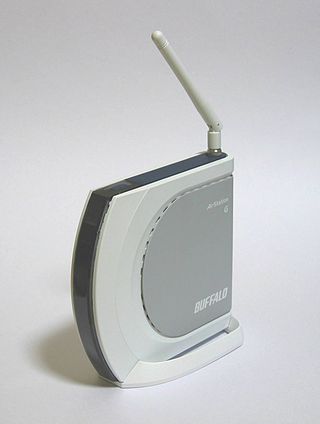
802.11 non-standard equipment is equipment that seeks to extend the Wi-Fi standard 802.11, by implementing proprietary features.

802.11 non-standard equipment is equipment that seeks to extend the Wi-Fi standard 802.11, by implementing proprietary features.
Chipmaker Atheros sells a proprietary channel bonding feature called Super G [1] for manufacturers of access points and client cards. This feature can boost network speeds up to 108 Mbit/s by using channel bonding. Also range is increased to 4x the range of 802.11g and 20x the range of 802.11b. This feature may interfere with other networks and may not support all b and g client cards. In addition, packet bursting techniques are also available in some chipsets and products which will also considerably increase speeds. This feature may not be compatible with other equipment.
Broadcom, another chipmaker, developed a competing proprietary frame-bursting feature called "125 High Speed Mode" [2] or Linksys "SpeedBooster", in response to criticism of Super G's interference potential.
U.S. Robotics also had a "MAXg" line of wireless products boasting 125 Mbit/s (actual throughput 35 Mbit/s) and about a 75% increase in signal range from the 802.11g standard. [3] Based on tests performed by KeyLabs on March 23, 2005 the MAXg series consistently outperformed the equivalent proprietary solutions and some of the "Draft 802.11n" solutions from other developers; more than one year before commercially available "pre N" or "Draft N" adapters. [4]
Various vendors implement proprietary TDMA polling modes, including Ligowave iPoll2/iPoll3, Mikrotik Nstreme/Nv2, [5] and Ubiquiti airMAX. [6] Such modes are generally incompatible with each other, nor with standard 802.11 clients.
These modes are frequently used for long-range dedicated links and/or by wireless Internet service providers, as they by design avoid the hidden node problem present in regular (CSMA/CD) Wi-Fi links.

IEEE 802.11 is part of the IEEE 802 set of local area network (LAN) technical standards, and specifies the set of medium access control (MAC) and physical layer (PHY) protocols for implementing wireless local area network (WLAN) computer communication. The standard and amendments provide the basis for wireless network products using the Wi-Fi brand and are the world's most widely used wireless computer networking standards. IEEE 802.11 is used in most home and office networks to allow laptops, printers, smartphones, and other devices to communicate with each other and access the Internet without connecting wires. IEEE 802.11 is also a basis for vehicle-based communication networks with IEEE 802.11p.

A wireless LAN (WLAN) is a wireless computer network that links two or more devices using wireless communication to form a local area network (LAN) within a limited area such as a home, school, computer laboratory, campus, or office building. This gives users the ability to move around within the area and remain connected to the network. Through a gateway, a WLAN can also provide a connection to the wider Internet.

AirPort is a discontinued line of wireless routers and network cards developed by Apple Inc. using Wi-Fi protocols. In Japan, the line of products was marketed under the brand AirMac due to previous registration by I-O Data.

Wi-Fi is a family of wireless network protocols based on the IEEE 802.11 family of standards, which are commonly used for local area networking of devices and Internet access, allowing nearby digital devices to exchange data by radio waves. These are the most widely used computer networks, used globally in home and small office networks to link devices and to provide Internet access with wireless routers and wireless access points in public places such as coffee shops, hotels, libraries, and airports.

In computer networking, a wireless access point (WAP) is a networking hardware device that allows other Wi-Fi devices to connect to a wired network or wireless network. As a standalone device, the AP may have a wired or wireless connection to a switch or router, but in a wireless router it can also be an integral component of the networking device itself. A WAP and AP is differentiated from a hotspot, which can be a physical location or digital location where Wi-Fi or WAP access is available.
IEEE 802.11n-2009, or 802.11n, is a wireless-networking standard that uses multiple antennas to increase data rates. The Wi-Fi Alliance has also retroactively labelled the technology for the standard as Wi-Fi 4. It standardized support for multiple-input multiple-output (MIMO), frame aggregation, and security improvements, among other features, and can be used in the 2.4 GHz or 5 GHz frequency bands.

High-speed multimedia radio (HSMM) is the implementation of high-speed wireless TCP/IP data networks over amateur radio frequency allocations using commercial off-the-shelf (COTS) hardware such as 802.11 Wi-Fi access points. This is possible because the 802.11 unlicensed frequency bands partially overlap with amateur radio bands and ISM bands in many countries. Only licensed amateur radio operators may legally use amplifiers and high-gain antennas within amateur radio frequencies to increase the power and coverage of an 802.11 signal.

A home network or home area network (HAN) is a type of computer network that facilitates communication among devices within the close vicinity of a home. Devices capable of participating in this network, for example, smart devices such as network printers and handheld mobile computers, often gain enhanced emergent capabilities through their ability to interact. These additional capabilities can be used to increase the quality of life inside the home in a variety of ways, such as automation of repetitive tasks, increased personal productivity, enhanced home security, and easier access to entertainment.
Qualcomm Atheros is a developer of semiconductor chips for network communications, particularly wireless chipsets. The company was founded under the name T-Span Systems in 1998 by experts in signal processing and VLSI design from Stanford University, the University of California, Berkeley, and private industry. The company was renamed Atheros Communications in 2000 and it completed an initial public offering in February 2004, trading on the NASDAQ under the symbol ATHR.
Super G is a proprietary method to increase the throughput of an IEEE 802.11g (Wi-Fi) wireless LAN. Atheros uses frame-bursting, compression, and channel bonding technology to improve performance. The throughput transmission speed limit when using Super G is claimed to be up to 40 Mbit/s-60 Mbit/s at a 108 Mbit/s signaling rate, which is achieved through the bonding of two 54 Mbit/s 802.11g channels.
Nitro from Conexant is a proprietary 802.11g performance enhancement technology introduced in 2003 as part of the PRISM chipset. The first implementation was designed to help compensate for the performance loss of higher-speed 802.11g devices when they share a wireless network with slower 802.11b devices.
Xpress technology is Broadcom's standards-based frame-bursting approach to improve 802.11 wireless LAN performance. It is a software-based implementation of the frame-bursting originally in the IEEE 802.11e draft specification, and is found in the Wireless Multimedia Extensions (WME) specification. It is not only designed to improve network efficiency but also boost throughput speeds of 802.11g and is particularly successful in mixed environments with 802.11a/b/g networks. It is one of the early enhancement technologies designed for 802.11 but it was preceded by Intersil's Prism Nitro and Atheros' Super G. Nitro was able to improve speed 3 times while Xpress posted 6 times improvement in mixed mode condition.
The DG834 series are popular ADSL modem router products from Netgear. The devices can be directly connected to a phone line and establish an ADSL broadband Internet connection to the ISP and share it among several computers via 802.3 Ethernet and 802.11b/g wireless data links.
Frame-bursting is a communication protocol feature used at the link layer in communication networks to alter the transmission characteristics in order to benefit from higher throughput. It is a technique sometimes used in communication protocols for shared mediums to achieve higher throughput by allowing the transmitter to send a series of frames in succession without relinquishing control of the transmission medium. Related techniques used to achieve the same goal include fast frames wherein the inter-frame wait interval is reduced, and jumbo frames wherein the size of the frame is increased. Frame bursting may also benefit from packet aggregation. Communication protocols for shared mediums are designed to relinquish the medium and wait for a while after the transmission of a MAC layer frame in order to facilitate the fair use of the medium by multiple users. Frame bursting may be permissible in certain scenarios such as when the link is point-to-point or when the signal from other users is indistinguishable from noise. Frame bursting allows for more data packets per time interval at the cost of wait time for other users.
IEEE 802.11a-1999 or 802.11a was an amendment to the IEEE 802.11 wireless local network specifications that defined requirements for an orthogonal frequency-division multiplexing (OFDM) communication system. It was originally designed to support wireless communication in the unlicensed national information infrastructure (U-NII) bands as regulated in the United States by the Code of Federal Regulations, Title 47, Section 15.407.
IEEE 802.11b-1999 or 802.11b is an amendment to the IEEE 802.11 wireless networking specification that extends throughout up to 11 Mbit/s using the same 2.4 GHz band. A related amendment was incorporated into the IEEE 802.11-2007 standard.
IEEE 802.11g-2003 or 802.11g is an amendment to the IEEE 802.11 specification that operates in the 2.4 GHz microwave band. The standard has extended link rate to up to 54 Mbit/s using the same 20 MHz bandwidth as 802.11b uses to achieve 11 Mbit/s. This specification, under the marketing name of Wi‑Fi, has been implemented all over the world. The 802.11g protocol is now Clause 19 of the published IEEE 802.11-2007 standard, and Clause 19 of the published IEEE 802.11-2012 standard.

Buffalo AirStation is the name given to a series of wireless LAN equipment sold by Buffalo Technology.
IEEE 802.11ac-2013 or 802.11ac is a wireless networking standard in the IEEE 802.11 set of protocols, providing high-throughput wireless local area networks (WLANs) on the 5 GHz band. The standard has been retroactively labelled as Wi-Fi 5 by Wi-Fi Alliance.

Wi-Fi 6, or IEEE 802.11ax, is an IEEE standard from the Wi-Fi Alliance, for wireless networks (WLANs). It operates in the 2.4 GHz and 5 GHz bands, with an extended version, Wi-Fi 6E, that adds the 6 GHz band. It is an upgrade from Wi-Fi 5 (802.11ac), with improvements for better performance in crowded places. Wi-Fi 6 covers frequencies in license-exempt bands between 1 and 7.125 GHz, including the commonly used 2.4 GHz and 5 GHz, as well as the broader 6 GHz band.